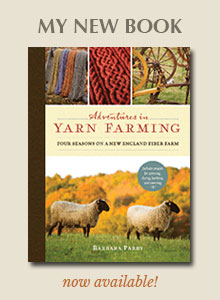When it comes to barn chores on winter mornings, Mike is a trooper. Since the start of the new year, I've been under the weather off and on. He's been a super good sport about tackling morning barn chores solo for the better part of last four weeks. In mid winter, morning chores on a New England sheep farm are like an endurance test. You work quickly and efficiently.
Inside the carriage barn where the rams spend the winter, square bales of hay are neatly stacked from the floor to the rafters. The stack is beside the row of feeders outside the sheep pen. By removing bales from the side of the stack, we create steps to the top of the hay stack. We feed from the top and work our way down. This stack was rafter high in November. Now it's about two thirds that height, which turns out to be a very good thing.
Let me start by commenting on barn chores, which can feel tedious at this time of year. As with any set of routine tasks, you tend to operate on autopilot. Don't we all have tasks that we perform almost by rote each day, without second thought? Walking the dog, taking out the trash, scraping a frozen windshield.
Feeding sheep is like that. Climb the stack of hay bales. Yank a few bales by the twine – send them to the floor. Descend hay stack. Cut strings. Drop flakes into the feeders. The process takes ten minutes, maybe less.
While doing morning chores Wednesday, as Mike reached for the strings on a top bale, the bale on which he was standing kicked out from the stack sending him reeling backwards. Reflexively he grasped for the only objects within arms reach (more hay bales). But as Mike tumbled, so did nearly all the square bales on the north face of the hay stack.
Had he had landed amidst the tumbled bales, the outcome would have been less painful. Unfortunately for Mike, the hay feeder closest to the hay stack broke his fall. Our hay mangers are plywood troughs, about 8 feet long. The inside is V shaped, with a slanted wire mesh panel on the front facing the sheep and a slanted plywood panel on the back facing the shepherd. Mike landed inside the V, catching the edge of the outer plywood on his leg.
Sheep are use to seeing hay flakes, not people, dropped into their manger at breakfast. They all bolted out through the small door you can see in the pic above.
While Mike was stranded in the hay feeder – trying to assess the damage to his leg and backside – I was bustling about the farm getting ready for a meeting in Greenfield with my bookkeeper. Right about the time he was pulling himself out of the manger I was just yards away in the dairy barn collecting employee time slips for payroll. Instead of calling me (he said he heard my car running outside), he brushed the chaff from his parka and finished feeding the sheep. Then he headed home to ice his leg.
I didn't hear this story until I returned home early afternoon. Aside from a spectacularly colorful bruise mid thing, Mike is unscathed. Very darn lucky – this could have been a disaster. Sometimes I tease Mike – as rugged as he is, he seems at times too accident prone for farming.
He texted me the above photo of the boys lounging in the barn, taken in a peaceful moment just before his tumble from the top of the haystack.
This post is a cautionary tale – beware of the mundane, stay mindful in daily tasks. And keep your smart phone in your pocket during barn chores!




